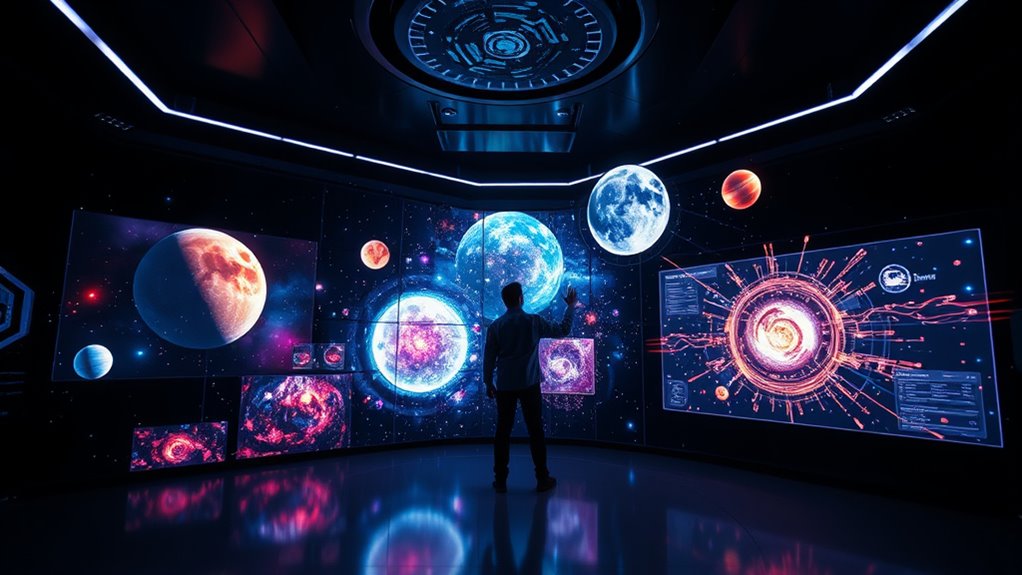Holographic displays are quickly moving from sci-fi dreams to real-world applications. With advancements in 3D visualization and augmented reality, holograms now appear more immersive and accessible without bulky equipment. Industries like healthcare, retail, and education are already using this tech for realistic models and interactive experiences. While we’re not quite at full Star Wars holo levels yet, continued innovations mean you’ll soon see more lifelike holograms in daily life. Keep exploring to discover how close this future really is.
Key Takeaways
- Modern holographic displays now project 3D images that appear to float in space, similar to sci-fi holos.
- Integration of AR technology enhances holographic experiences without the need for special glasses.
- Industry applications like medical imaging, architecture, and retail demonstrate practical, immersive 3D visualization.
- Touch-enabled and interactive holograms allow manipulation of virtual objects in real time, advancing realism.
- Continuous technological progress is bringing holographic displays closer to Star Wars-like immersive, full-spectrum holograms.

Holographic displays are transforming the way we visualize digital content by projecting three-dimensional images that appear to float in space. This technology isn’t just a futuristic concept; it’s actively shaping industries and changing how you interact with information. By integrating augmented reality with holographic displays, developers can create immersive experiences that blend the physical and digital worlds seamlessly. Imagine walking into a room where you can see a 3D model of a product hovering in front of you, or visualizing complex data overlays in real time. This isn’t science fiction—it’s the power of advanced holography combined with AR, opening new avenues for education, entertainment, and even daily communication.
Holographic displays and AR are revolutionizing digital visualization and interaction across industries.
With 3D visualization at its core, holographic displays allow you to perceive depth and spatial relationships more naturally than traditional screens. Instead of viewing a flat image, you’re engaging with a three-dimensional object that you can rotate, examine from different angles, or even manipulate with your hands if touch-enabled interfaces are integrated. This ability enhances understanding and retention of complex information. For instance, architects can showcase building models in full scale, giving clients a tangible sense of space and design. Medical professionals can explore detailed anatomical structures, improving diagnostics and surgical planning. In retail, holographic displays enable customers to see how a piece of furniture might look in their home, reducing uncertainty and increasing confidence in purchasing decisions. As the technology improves, the potential for visualization tools to revolutionize various sectors continues to grow.
The incorporation of augmented reality into holographic displays makes these experiences even more compelling. AR overlays digital images onto your real-world environment, creating a mixed-reality experience that feels intuitive and natural. You don’t need special glasses or headsets in many cases; simply look at a designated space or use a compatible device to see the holograms come to life. This convergence of AR and holography accelerates the adoption of 3D visualization across various fields, making digital content more accessible and engaging. You could attend a virtual conference where speakers appear as floating holograms, or participate in interactive training sessions that feel remarkably real.
As holographic display technology advances, the dream of seeing Star Wars-like holos become reality edges closer. Today’s innovations are bringing us closer to a future where holograms aren’t confined to sci-fi movies but are integrated into everyday life. Whether for work, education, or entertainment, the ability to project and interact with 3D visuals adds a new layer of depth to digital experiences. The seamless blend of augmented reality and holography promises a world where digital content feels more tangible, more immersive, and more connected to our real world. It’s an exciting evolution that’s transforming the way you see and interact with information every day.
Frequently Asked Questions
How Close Are Current Holograms to Star Wars Level Displays?
Current holograms are making strides toward Star Wars-style displays, but they still fall short in visual fidelity and immersion. With advancements in augmented reality, you can experience more interactive and realistic holographic images, yet true holograms like those in sci-fi movies remain a bit out of reach. Researchers are working hard, so expect improvements, but for now, you’re still a few steps away from fully immersive, Star Wars-like holos.
What Are the Main Technological Barriers to Perfect Holographic Displays?
You face main barriers like material limitations, which hinder creating clear, stable holograms, and high energy consumption that makes sustaining such displays impractical. Developing advanced materials that can handle light manipulation without degrading is essential. Additionally, reducing power needs is vital for portability and everyday use. Overcoming these hurdles requires innovative research, but progress could bring you closer to achieving Star Wars-style holographic displays.
Can Holograms Be Used in Everyday Consumer Devices Soon?
Ever wondered if holograms will soon be part of your daily life? It’s likely you’ll see holograms in consumer devices soon, especially through augmented reality glasses and smartphones. They’ll revolutionize virtual meetings, making interactions more immersive and lifelike. Although some technological hurdles remain, rapid advancements suggest holograms could become commonplace, transforming how you connect, communicate, and entertain every day. Are you ready to see the future unfold before your eyes?
How Do Holographic Displays Impact Privacy and Security Concerns?
Holographic displays raise serious privacy and security concerns. You might worry about data privacy, as sensitive information could be intercepted or misused through hologram interactions. Security vulnerabilities could allow hackers to manipulate or access holographic content, risking personal or confidential data. To protect yourself, stay updated on security measures, use strong authentication, and be cautious about sharing private information through holographic interfaces.
Are There Health Risks Associated With Prolonged Exposure to Holograms?
You might feel like your eyes are caught in a never-ending light show, and that’s because prolonged exposure to holograms can pose visual health risks. You risk eye strain, fatigue, and even headaches if you stare at holographic displays for too long. It’s like overloading your visual system with too much brightness and focus. To protect your eyes, take regular breaks and keep a safe distance from persistent hologram exposure.
Conclusion
So, as you watch holographic displays leap from science fiction to everyday reality, you realize we’re on the brink of a technological revolution that’s happening faster than you can say “lightsaber.” These displays are no longer just a flicker of imagination but a stunning glimpse into the future where holograms could dominate your world. Buckle up, because what’s coming next isn’t just cool—it’s universe-shaking, and you’re right in the middle of it.









